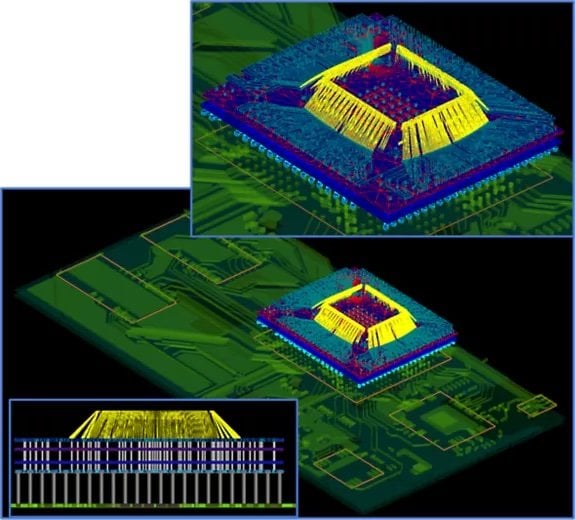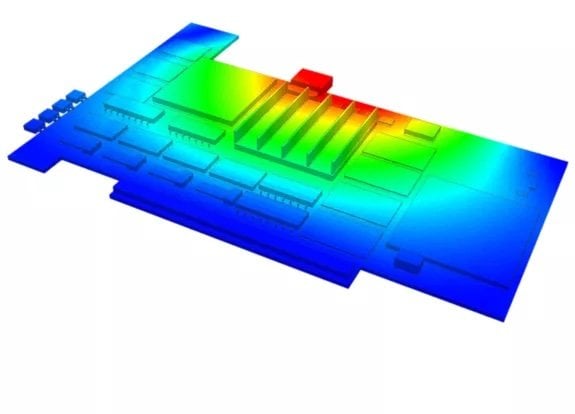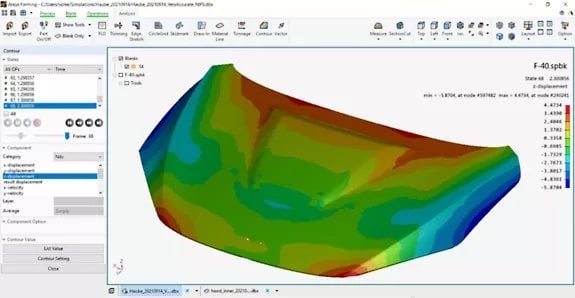Elevate Engineering Simulation with Ansys 2022 R1
New products, breakthrough technologies, and customized workflows from Ansys take product design and development to a new level.

"Phi Plus meshing technology brings extraordinary speed and robustness to complex system simulation including 3D IC packaging challenges"
Key Highlights
- New products deliver unique solutions to tough industry challenges
- Breakthrough technologies accelerate innovation at every scale and stage of the engineering process
- New customized workflows and automation improve collaboration and increase productivity for experts and non-experts alike
Ansys (NASDAQ: ANSS) software and services reduce obstacles to enable customers to solve today’s complex engineering challenges. Engineering simulation has expanded beyond highly specialized experts and into mainstream product design and development, enabling more companies to save time, reduce costs, and innovate. At the same time, engineering complexity has skyrocketed, requiring organizations to scale like never before, driving demand for advanced computing resources and cross-discipline engineering solutions. The new products, technologies, and tools that make up Ansys 2022 R1 enable experts to go deep with custom workflows for industry-specific applications while also extending broad ease-of-use features that turbocharge collaboration across teams.
"Schneider Electric leverages Ansys simulation to accelerate key business initiatives, improving the quality of our products while making them smarter. This is an enabler of our vision for a more sustainable, energy-efficient future,” said Jayaraman Raghuraman, senior vice president of Schneider Electric. “Ansys expertise and cutting-edge technology accelerate our digital transformation and help us simplify the application landscape across our engineering organization.”
New, industry-focused solutions are expanding the definition of what is possible. Ansys 2022 R1 includes a dedicated aerospace workspace in Ansys Fluent that tailors the user interface to external aerodynamics simulations, enabling aircraft designers to evaluate aircraft efficiency and study dynamics from subsonic to very high-speed flows. Similarly, the new Ansys Forming product enables engineers to digitally design and validate every step of the sheet metal forming process commonly found in automotive, appliances, aerospace, and packaged goods industries. Ansys RF Advisor On Demand is targeted specifically to help engineers solve the challenge of radio frequency interference for the next generation of high-tech devices.
With 2022 R1, Ansys continues to bring ground-breaking technologies to address printed circuit board (PCB) and 3D IC (integrated circuit) package design challenges as well as advancements in 5G, autonomous, and electrification simulation. Building on the success of HFSS Mesh Fusion, the introduction of the Phi Plus meshing technology brings extraordinary speed and robustness to complex system simulation including 3D IC packaging challenges. In semiconductors, 2022 R1 introduces RedHawk-SC SigmaDVD, a technology breakthrough that identifies the worst-case dynamic voltage-drop in hours instead of months. This novel, statistically realistic modeling technique makes it possible to achieve near 100% coverage of all relevant switching scenarios of neighboring cells, making chip designs more robust and giving chip designers greatly expanded confidence in RedHawk-SC’s golden signoff analysis. New workflows and integrations in Ansys 2022 R1 produce even greater insight into product performance. In this latest release, Ansys Sherlock features a new, semi-automated workflow that takes advantage of integrations with Ansys AEDT Icepak to deliver more predictively accurate thermal analysis simulations for PCBs.
"The importance of electronics is continuously increasing in the automotive industry,” said Dr. Pascal Schirmer, development engineer Power Electronics at BMW Group. “The use of simulation tools from Ansys, such as Ansys Sherlock, allows us to optimize, in a very early design phase, the performance and reliability of the electronic components while managing for the growing complexity.”

"Ansys Sherlock allows for optimization of performance and reliability of electronic components"
Managing complexity to achieve both speed and predictive accuracy is critical to nearly every industry. Increasingly, these next-generation products require integrated semiconductors and electronics along with embedded software, advanced sensors, and displays. Product success requires consideration of how a full system will operate in a broad context that encompasses traditional design and extends into operation effectiveness. Ansys solutions help design teams meet stringent requirements for functional safety, industry-standards’ compliance, and long-term operational reliability. Ansys 2022 R1 delivers product offerings that complement traditional multiphysics with safety, reliability, cybersecurity, digital mission engineering, and digital twins.
The optical technologies offered by Ansys span from Ansys Lumerical at the microscale, to Ansys Zemax at the macroscale, all the way to human and sensor perception for systems with Ansys Speos. The Ansys 2022 R1 release delivers increased functionality supporting Ansys' unique and comprehensive solution for the design of optical and photonic devices in datacom, consumer electronics, automotive, aerospace, healthcare, and more. On the other end of the scale are enormous simulations to support digital mission engineering like Ansys STK (Systems Tool Kit) that now includes enhanced tools to support large satellite mega-constellations being evaluated and designed across the commercial space industry. In between are examples from nearly every industry where fast, high-fidelity simulations of increasingly complex phenomena are needed to meet tight product development deadlines.
Another means to meet those deadlines is to pair advanced simulation with high-performance computing (HPC) resources. With Ansys 2022 R1, many more applications support Ansys Cloud and take advantage of the power that the latest graphics processing units (GPUs) can provide. For example, a new Multi-GPU solver available in Fluent accelerates steady-state computational fluid dynamics (CFD) simulations, producing results that show four high-end GPUs provide the same performance as more than 1,000 CPUs, while reducing hardware costs by up to 7x and power consumption by up to 4x. Ansys 2022 R1 also expands Ansys Discovery’s astonishing live physics in the critical area of thermal management through the addition of coupled fluid-solid multiphysics simulation. This fast, fault-tolerant approach means that the simulation of heat exchangers, liquid cooling devices, and exhaust systems is now markedly easier to perform and up to 50x faster allowing for even greater design exploration.

"Ansys Forming enables engineers to digitally design and validate every step of the sheet metal forming process"
“Speed, fidelity, and scalability are crucial to integrating simulation across the enterprise, enabling engineers to connect with global collaborators to keep pace with innovation in high-growth areas, such as autonomous vehicles, electrification, and artificial intelligence,” said Shane Emswiler, senior vice president of products at Ansys. “The new features in Ansys 2022 R1 enable engineers to both solve more complex challenges and expand the reach of simulation’s benefits.”
To learn more about Ansys 2022 R1, please visit: www.ansys.com/products/release-highlights.
For specific updates on each of Ansys' product suites, please visit:
- Autonomous Vehicle Simulation
- Digital Mission Engineering
- Digital Twins
- Safety Analysis
- Optics and VR
- Embedded Software
- Structures
- 3D Design
- Electronics
- Fluids
- Materials
- Semiconductors
- Platform
- Additive Manufacturing
- Photonics

